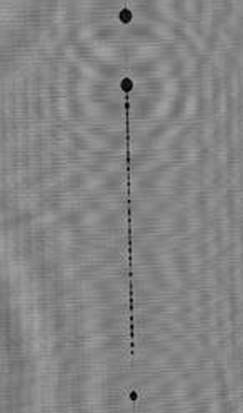
Marie-Charlotte Renoult, Gilles Godard, Maxime Kozulic and Denis Lebrun
Digital holography is applied to the visualization of viscoelastic flows due to the presence of polymers with high molecular weight in the studied liquids.
The experiment is carried out on a filament stretching device of the CABER (Capillary Breakup Extensional Rheometer) type. It is a geometry where a viscoelastic filament is stretched between two plates in a controlled manner. For certain concentrations of polymers, we observe the appearance of small drops (or beads) moving on the filament. The figure below shows the reconstructed hologram of a zone of the filament.
This optical device is very simple: the flow is illuminated by a laser beam and the holographic figure produced by the filament is directly recorded on a camera without an imaging lens (lensless imaging system). By reconstructing the hologram plane by plane, it is possible to focus on each image. It thus becomes possible to characterize finely:
- the dynamics of the sizes and positions of the beads
- the evolution of the filament size
without prior knowledge of the 3D position of the objects.
More details on the following movie: link.
M. Kozulic,M. Mirzaei, G. Godard, D. Lebrun, O. Crumeyrolle, MC. Renoult. 3D monitoring of a pearling instability. APS Division of Fluid Dynamics, 2019, Portland, United States. ⟨hal-02418339⟩ V0034, 72th Annual Meeting of the APS Division of Fluid Dynamics (November 23, 2019 — November 26, 2019). DOI: https://doi.org/10.1103/APS.DFD.2019.GFM.V0034





